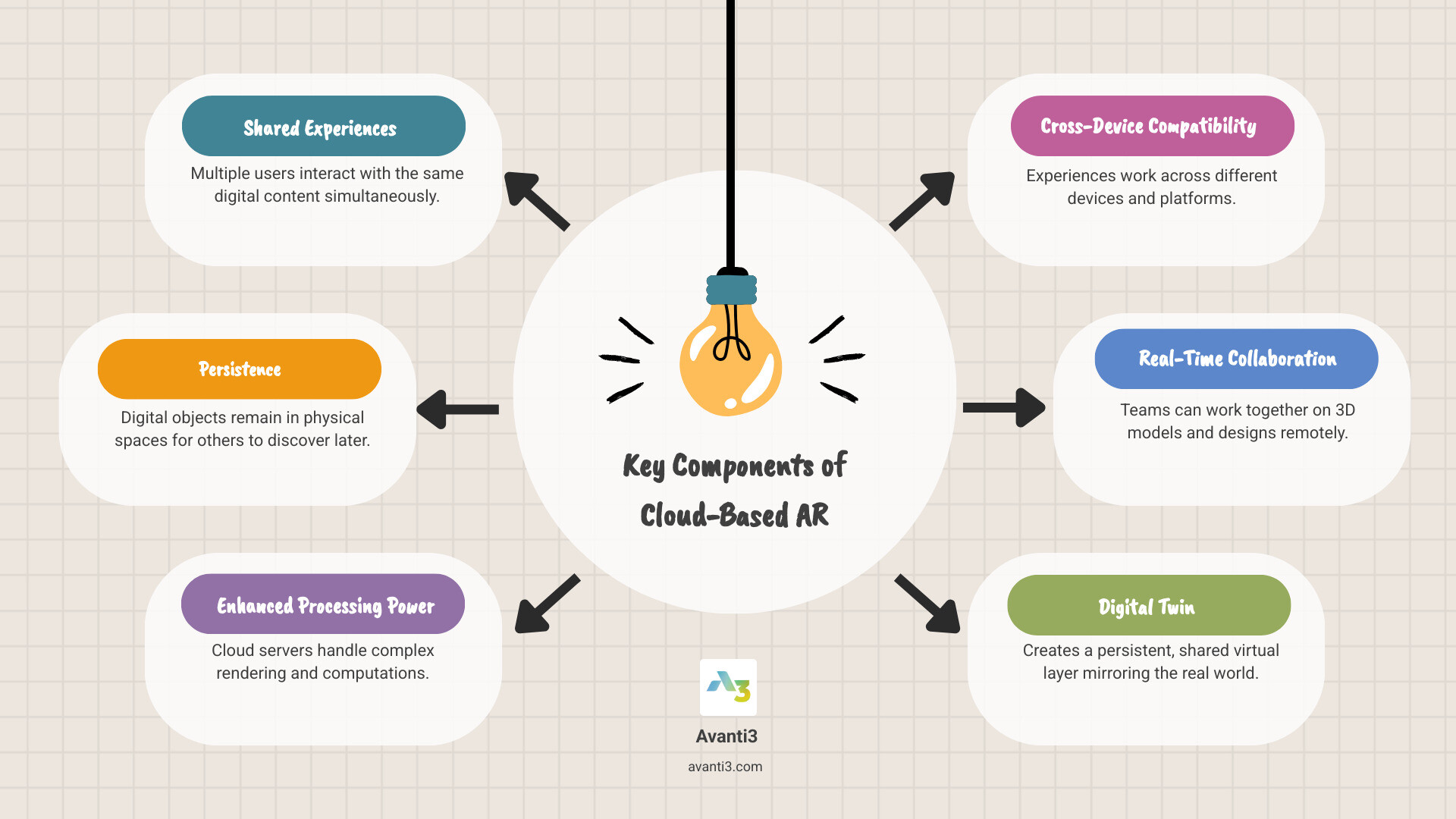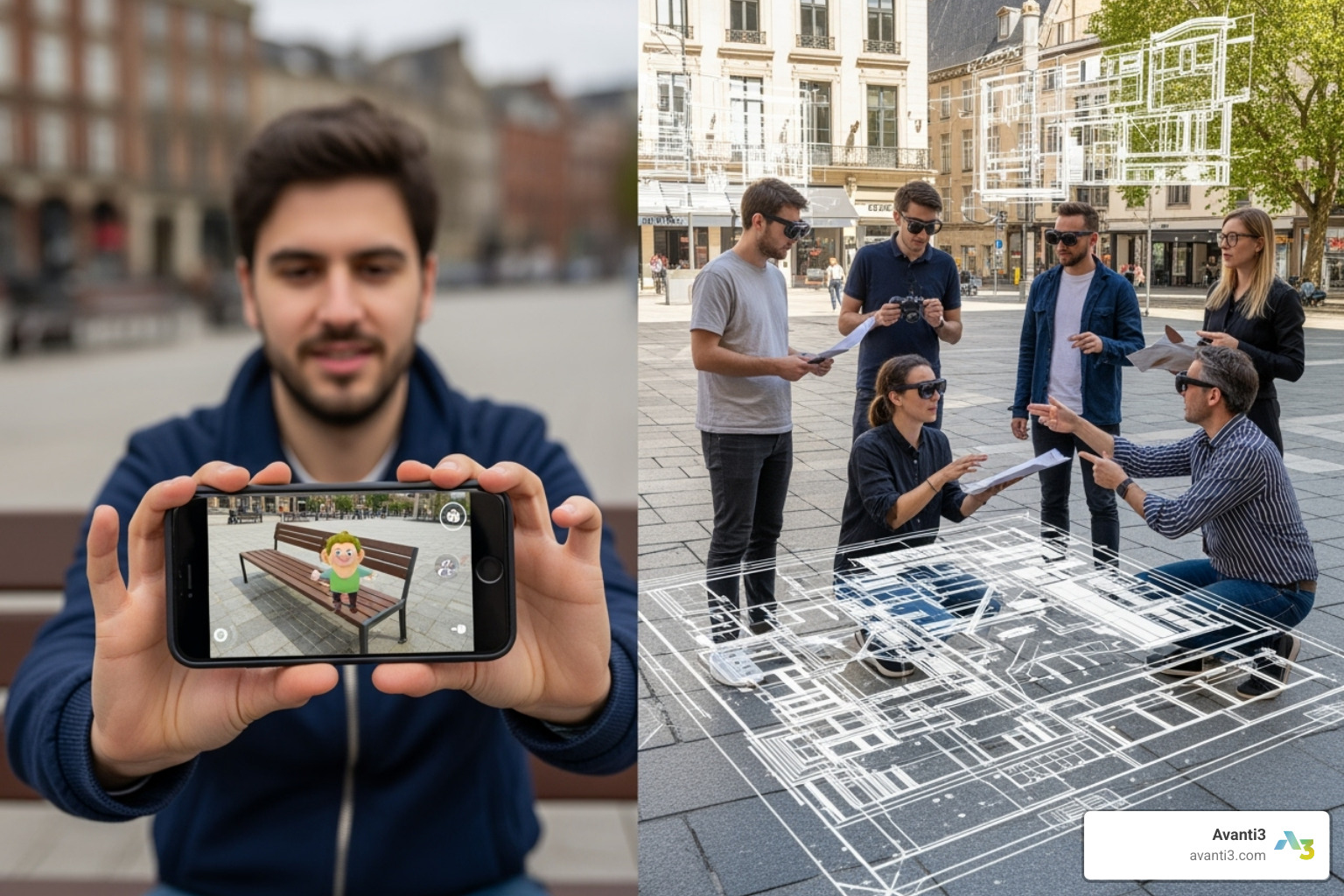Cloud Based AR: Game-Changer for 2025
The Next Digital Frontier: Why Cloud-Based AR Matters
Cloud based ar represents a shift from device-dependent augmented reality to a shared, persistent digital layer that exists across the internet. Unlike traditional AR that runs entirely on your device, cloud-based AR leverages remote servers to deliver richer, more collaborative experiences that persist in real-world locations.
Here’s what makes cloud-based AR different:
- Shared experiences: Multiple users can interact with the same digital content simultaneously
- Persistence: Digital objects remain in physical spaces for others to find later
- Improved processing power: Cloud servers handle complex rendering and computations
- Cross-device compatibility: Works across different devices and platforms
- Real-time collaboration: Teams can work together on 3D models and designs remotely
The numbers tell the story of AR’s explosive growth. In 2021, 810 million people used an AR program or app on mobile devices, with projections suggesting this will rise to 1.4 billion by 2024. The AR market could be worth $76 billion by 2030, with ABI Research predicting the AR Cloud specifically will reach $102 billion by 2024.
But what exactly is the “AR Cloud”? Think of it as a digital twin of the real world—a persistent, shared virtual layer that overlays our physical environment. This is a foundational technology that could reshape how we work, shop, learn, and interact with information.
Why should you care? Because cloud-based AR is becoming the backbone of the next internet, where digital information exists spatially in our world rather than being trapped behind screens. For creators, brands, and businesses, this represents unprecedented opportunities to engage audiences and create new revenue streams.
I’m Samir ElKamouny AV, an entrepreneur and marketing expert who has helped scale countless businesses through innovative technologies. My experience with cloud based ar has shown me how this technology transforms customer engagement and opens new pathways to success.

Understanding Cloud-Based AR: Beyond Your Device’s Limits
Traditional AR often pushes devices to their limits. Your phone or tablet has limited processing power, memory, and battery life. When AR apps try to render complex 3D objects and track multiple surfaces all at once, they quickly hit a wall. The result is often simpler experiences, shorter sessions, and frustrated users.
Cloud based ar changes everything by moving the heavy lifting off your device and onto powerful remote servers. Think of it as having access to a supercomputer in the sky that handles all the complex calculations, rendering, and data processing. Your device simply receives the finished experience, much like streaming a movie.

The magic happens through the AR Cloud—a digital twin of our world. When you place a virtual object in a park using cloud based ar, it doesn’t disappear when you close the app. It stays there for the next person to find.
This persistence transforms AR from a solo, temporary experience into a truly collaborative one. Multiple people can see and interact with the same digital objects in real-time. A design team in different cities can work together on a 3D prototype as if they’re in the same room.
The scalability is immense. While a phone might struggle with one complex 3D model, cloud servers can handle millions of digital objects across entire cities, supporting massive multiplayer experiences and storing virtually unlimited content.
By overcoming device limitations, cloud based ar opens the door to experiences we could only dream about before: rich graphics, persistent social spaces, and collaborative tools that make distance irrelevant.
| Feature | Traditional (On-Device) AR | Cloud-Based AR |
|---|---|---|
| Processing Power | Limited by device CPU/GPU | Leverages remote server clusters (CPUs/GPUs) for massive power |
| Data Storage | Stored on device, limited capacity | Stored in the cloud, virtually unlimited |
| Persistence | Often session-based; digital content disappears when app closes | Persistent in real-world locations; content remains for later interactions |
| Multi-User Interaction | Very limited or non-existent | Real-time, seamless multi-user collaboration and shared experiences |
| Scalability | Difficult to scale complex experiences | Highly scalable; can support millions of users and vast digital content |
| Content Complexity | Restricted by device capabilities | Can handle highly detailed graphics, complex simulations, and large datasets |
| Access | Requires app download/installation | Often web-based (WebAR) or device-agnostic; easier access |
| Latency | Minimal internal latency | Relies on network speed; can be a challenge if not managed well |
The result is a shared digital layer that exists everywhere, accessible to everyone, and limited only by our imagination rather than our hardware. This is the foundation for the next generation of digital experiences.
The Core Technology Powering the AR Cloud
Cloud based ar relies on a sophisticated orchestra of technologies working behind the scenes. When you point your phone at a street corner and see directions floating in the air, it’s thanks to powerful server farms and smart data processing.
Computer vision acts as the eyes of the system, allowing AR to “see” and understand the world. It analyzes the camera feed to identify walls, floors, and objects, telling the system where to place digital content so it looks like it belongs in the real world.
While GPS tells you which block you’re on, Visual Positioning Systems (VPS) can pinpoint your location down to the centimeter. VPS uses visual clues from your surroundings—like the pattern of windows on a building—to determine your exact position and orientation. This accuracy is what makes digital objects appear rock-solid.
The Three Pillars of the AR Cloud
Every cloud based ar experience rests on three essential pillars:
- Scalable point cloud and 3D mapping: This is a detailed digital copy of the world, built from millions of data points that map the exact shape and position of physical objects. It’s a full 3D digital twin, not a flat map.
- Instant localization: Using VPS, the system can instantly figure out your exact position within that massive 3D map, allowing for pinpoint-accurate placement of digital content anywhere in the world.
- Real-time multi-user interaction and experience synchronization: This pillar enables multiple people to see and interact with the same digital objects simultaneously. Thanks to persistence, these experiences can stick around long after you’ve left.
Key Enabling Technologies for Cloud-Based AR
Several breakthrough technologies make cloud based ar incredibly powerful.
5G networks are game-changing, providing the high speeds and ultra-low latency needed for instant, natural-feeling AR interactions.
Edge computing reduces response times even further by processing data at nearby locations instead of sending it to a distant server.
Remote rendering and pixel streaming offload the heavy graphics processing to powerful cloud servers. They create the visuals and stream the finished images to your device, much like Netflix streams a movie.
AI and machine learning serve as the brain of the system. These technologies help the system not just see objects but understand what they are and how they relate to each other. This allows for smarter, more natural interactions and improves accuracy over time.
Why Cloud-Based AR is a Game-Changer: Key Benefits and Advantages
Cloud based ar is more than a buzzword; it’s a paradigm shift for digital experiences and business strategy. It solves the technical frustrations of traditional AR while open uping new potential for users and businesses alike.

Benefits for Users
The user experience change is remarkable. Richer, higher-quality experiences become possible when we’re not limited by a single smartphone. Imagine photorealistic virtual objects with lifelike physics, streamed seamlessly from the cloud.
Shared social interactions change everything. You and your friends can see and interact with the same digital objects in real-time, turning AR into a truly social medium. For deeper insights, check out our AR/VR immersive experiences.
Device accessibility is a game-changer for adoption. Older smartphones can run the same sophisticated AR experiences as the latest flagship devices, democratizing access for everyone.
Persistent contextual information creates a living digital layer over our world. A virtual restaurant review or art installation can stay in a location for others to find later.
Advantages for Businesses
For businesses, cloud based ar opens doors that were previously locked. Improved customer engagement is a key benefit, with some companies reporting 3X increases in add-to-cart rates when customers can virtually try products. This is the future of Augmented Reality Marketing.
Improved collaboration transforms teamwork. Architects can walk clients through virtual buildings on-site, and engineers can troubleshoot equipment remotely with shared digital mock-ups.
Scalable solutions allow businesses to create experiences for millions of users simultaneously, opening up new revenue streams from virtual showrooms to location-based digital events. At Avanti3, we’re excited about integrating blockchain to enable true ownership of digital assets with Augmented Reality NFTs.
Data and analytics provide unprecedented insights into how people interact with products and spaces in 3D, moving beyond simple click-through rates to understand true user engagement.
Real-World Applications of Cloud-Based AR Across Industries
The applications for cloud based ar are already changing how we shop, work, and play. From retail stores to factory floors, this technology is making the impossible feel natural.
Retail and E-commerce
Virtual “try-before-you-buy” experiences let you visualize products like furniture in your own home, perfectly scaled. This removes the uncertainty of online shopping, with some retailers seeing 5X increases in product views and 3X increases in add-to-cart rates. In-store navigation can guide you through large stores, while interactive advertising brings static displays to life.
Navigation and Tourism
Cloud based ar is changing how we steer by overlaying improved wayfinding directly onto the world. Imagine seeing navigation arrows on the sidewalk or having street signs instantly translated. For tourists, interactive historical tours can bring ancient ruins back to life, showing how they looked centuries ago. These Virtual Art Experiences create a deeper emotional connection to places and their stories.
Industrial and Enterprise
In professional settings, cloud based ar is solving major industry challenges. With remote assistance, an expert can see what a field technician sees and overlay step-by-step repair instructions onto the equipment. Field technician training is safer and more efficient with virtual equipment. For collaborative design, global teams can work together on shared 3D models in real-time. In logistics, warehouse workers can see picking routes overlaid on the floor, reducing errors and speeding up operations. These are practical AR for Enterprise Solutions that boost efficiency and safety.
Entertainment and Gaming
Gaming is where cloud based ar gets truly exciting. Massive multi-user games can support thousands of players interacting in real-world locations. Location-based gaming turns your city into a dynamic game board, with persistent clues and characters for others to find. Live events are also being transformed. Sports fans can see player stats floating above the field, while concert-goers can witness virtual performers alongside real musicians in Augmented Reality Concerts that blur the line between physical and digital entertainment.
The Road Ahead: Challenges and the Future of the AR Cloud
The future of cloud based ar is incredibly promising, with market projections telling a compelling story. The AR market is projected to reach $76 billion by 2030, while the AR Cloud specifically could hit $102 billion by 2024. This explosive growth signals the birth of a foundational technology.
We are moving toward a world where you can “Google the world by just looking at it,” getting instant, contextual information overlaid on your field of view. The AR Cloud is the essential backbone for the Metaverse, enabling persistent, shared digital experiences that blend with our physical reality.

Overcoming the Problems for Cloud-Based AR
Of course, the technology faces challenges, but progress is being made.
- Latency remains the biggest technical hurdle, as AR requires near-instant responses. However, 5G, edge computing, and advanced rendering techniques are rapidly closing this gap.
- Data storage and processing for a 3D map of the world are immense, but infrastructure is evolving to meet these demands.
- Privacy and security concerns are valid. We need robust regulations and transparent systems to protect user data and ensure content integrity.
- Content creation tools must become more accessible to allow everyone to contribute to this shared digital layer.
- Interoperability and open standards are crucial to avoid fragmented “walled gardens” and ensure different platforms and devices work together seamlessly.
The Future Outlook
Despite these challenges, the future is bright. Major tech companies are investing heavily in spatial mapping and AR Cloud platforms. The AR Cloud is positioning itself as the foundational layer for the Metaverse, where digital information lives spatially.
At Avanti3, we see the integration of Web3 technologies like blockchain and NFTs as crucial for establishing true ownership of digital assets in the AR Cloud. This allows creators to monetize their work and users to truly own their digital possessions.
We’re also seeing a gradual shift toward AR glasses as the primary interface. These will offer truly immersive, hands-free experiences, making the digital layer feel completely integrated into daily life. The journey is collaborative, building a future where physical and digital realities merge.
Conclusion: Building Our Shared Digital Reality
We’ve moved far beyond simple phone filters to a technology that could fundamentally reshape our world. Cloud based ar offloads heavy processing to the cloud, creating experiences that are richer, more detailed, and truly shared. This creates a persistent digital layer over our physical world that multiple people can interact with at once.
This is all made possible by a convergence of technologies like 5G networks, edge computing, visual positioning systems, and AI. While challenges like latency and privacy remain, the momentum is undeniable. The AR Cloud is becoming the foundational layer for the Metaverse, changing how we interact with information and each other.
This future isn’t just about better technology; it’s about better human connection. It’s about building a more collaborative and social shared reality.
At Avanti3, we are passionate about being part of this change. By integrating Web3 technologies with AR, we help create a world where digital assets have real ownership and value. This is about empowering creators and brands to build meaningful communities through thoughtful Digital Experience Design.
The future of cloud based ar is collaborative. We’re not just building better apps; we’re constructing a shared digital reality that creates new ways to work, play, learn, and connect.
Ready to explore how this technology can transform your business? Find what’s possible with our AR/VR immersive experiences and join us in shaping this exciting new frontier.








